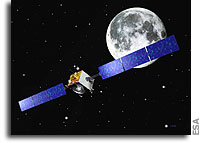SMART-1 Ion Engine Switched Off and Commissioning Begins

The spacecraft is now in its 207th orbit, in good status and with all
functions performing nominally. As in previous weeks, the ion drive has only
generated thrust around the perigee point to fine-tune the altitude of the
apogee point. This strategy has produced a noticeable increase in apogee
height, see plot below, which is necessary to minimize the duration of
eclipse periods that will occur during March.
The total cumulated thrust so far is more than 1705 hours, consuming 27.1 kg
of Xenon, has provided a velocity increment of about 1220 ms-1 (equivalent
to 4392 km per hour). In this period the electric propulsion engine’s
performance, periodically monitored by means of the telemetry data
transmitted by the spacecraft and by radio-tracking by the ground stations,
have been nominal.
The spacecraft subsystem continue to function well despite the known problem
of the hot star trackers. This can overload the star tracker computers,
because in these conditions they "see" many more stars and the search for
the correct constellation becomes heavier. In one case this overload caused
a loss of synchronisation between the star tracker time with the spacecraft
time.
The software patch, required to recover from the flame-outs, has been
prepared and will be uploaded to the spacecraft as soon as the electric
propulsion engine is operated again.
After four months of continuous travelling through the Earth’s radiation
belts the electric propulsion engine was switched off on 30 January. The
engine will remain dormant for a period of three weeks to allow the
instrument teams to switch on and test their instruments.
Commissioning Activities
After the last SMART-1 Science and Technology Working Team (STWT20) at ESOC,
15 January 2004, the payload operation preparation activities have
accelerated between PI teams, project, STOC and ESOC.
EDPE and SPEDE
The plasma diagnostic experiments have been operational since the first week
of the mission and have measured the spacecraft environment during both
periods of electric thrust and no electric thrust. Discussions about these
early results took place at a workshop held at ESTEC on 20 January.
AMIE
AMIE acquired its first image of a crescent moon on 18 January.
On 29 January, between 20:00 and 21:19 UT, images of the first quarter moon
were taken through several filters. The result is a small, but impressive,
image revealing, clockwise from the top: Mare Serenitatis, Mare
Tranquillitatis, Mare Fecunditatis and Mare Nectaris, with Mare Crisium also
visible near the limb.
The result is very encouraging as the spacecraft is still over 300 000 km
from the Moon. The camera appears to have survived its journey through the
high radiation environment with no apparent reduction in performance. Taking
images is also an excellent test of the pointing ability of the spacecraft.
KaTE
On 29 January, at around midnight, a test of the X-band downlink capability
of the KaTE transponder took place with the ground station in Perth,
Australia. The signal was successfully located and displayed with a good
lock at the station.
Planned Activities
5 – 10 February 2004
Instrument Activity
SIR Health check and scan of lunar infrared spectra
KaTE Further tests with ground stations
AMIE Targeted images
EPDP Instrument calibrations
SPEDE Instrument calibrations
11 – 18 February 2004
Instrument Activity
AMIE Alignment calibrations with startrackers and SIR
SIR Alignment calibrations with AMIE
KaTE Tests with ground stations
19 – 20 February 2004
Instrument Activity
D-CIXS Test when spacecraft at apogee
During March, there will be a period of EP thrusting and long eclipses,
which will limit the payload to simple operations at apogee. Once this
period has finished, normal operations can resume and an extended
commissioning and cruise science phase will operate from April-June during
the coast arcs.
A series of lunar resonance gravity assists will take place on 20 August, 16
September and 14 October. The STWT20 agreed to have only one lunar swingby,
on or around 9 November, before lunar capture takes place in early December.
After capture and down spiral, the xenon fuel reserves will lower the
apolune to the final science orbit.
Orbital/Trajectory information
The ESOC specialists periodically compute the osculating orbital elements.
These elements define the so-called "osculating orbit" which would be
travelled by the spacecraft if at that instant all perturbations, including
EP thrust, would cease. Therefore, it is an image of the situation at that
epoch. In reality, the path travelled by the spacecraft is a continuous
spiral leading from one orbit to another. The most recent osculating
elements are as follows:
EPOCH (UTC) 2004/02/01 22:46:08.6
Elements WRT Earth (J2000)
Pericentre Distance (km) 20 690.564436
Apocentre Distance (km) 65 869.221941
Semi Major Axis (km) 43 279.893189
Eccentricity 0.521936
Inclination (deg) 6.906311
Asc. Node (deg) 150.042887
Arg. of Pericentre (deg) 211.902998
True Anomaly (deg) 179.991681
Osc. Orbital Period (h) 24.890737
Contact Points
Giuseppe Racca
SMART-1 Project Manager
ESA/ESTEC – SCI-PD
Keplerlaan 1- 2200 AG Noordwijk, The Netherlands
E-mail: Giuseppe.Raccaesa.int
Bernard H. Foing
SMART-1 Project Scientist
ESA/ESTEC – SCI-SR
Keplerlaan 1- 2200 AG Noordwijk, The Netherlands
E-mail: Bernard.Foingesa.int








